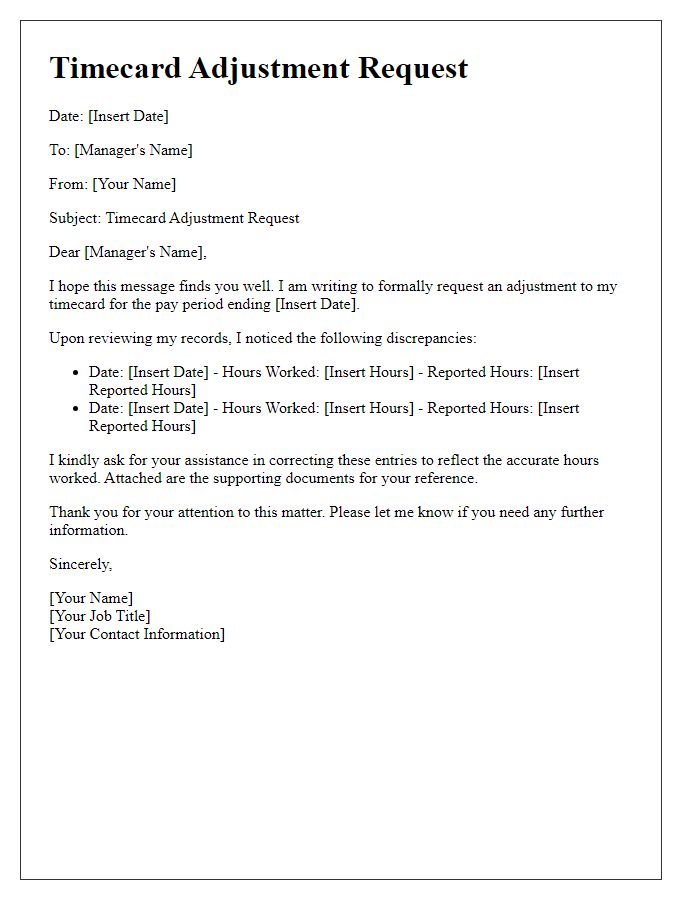Hey there! We all know that keeping track of our hours can sometimes lead to a few hiccups, right? That's why it's important to address any discrepancies in your timecards as soon as possible to ensure you're compensated accurately. In this article, we'll guide you through crafting a timecard correction notice that's clear and effective. So, let's dive in and get you on the right track!

Employee Information and Contact Details
An effective timecard correction notice requires accurate employee information and updated contact details. Employee name should include first and last names for proper identification. Employee ID, a unique number for payroll processing, assists in tracking records efficiently. Department name helps in routing the notice within the organization, ensuring it reaches the appropriate managerial staff. Job title provides clarity regarding the employee's role and responsibilities. Updated email address is crucial for electronic communication, while phone number offers an alternative contact method for urgent inquiries. Additionally, including the date of the correction notice promotes recordkeeping accuracy, enabling swift actions on discrepancies.
Description of the Timecard Discrepancy
A timecard discrepancy may arise when an employee's recorded hours do not align with the actual hours worked. Common reasons may include unintentional omissions due to forgetting to clock in or clock out, incorrect entry of hours on specific dates, or system errors in automated timekeeping systems like ADP or Kronos. For instance, if an employee was scheduled to work from 9 AM to 5 PM (totaling 8 hours) but only recorded 6 hours, this discrepancy needs addressing. Identifying the affected pay period (such as bi-weekly from September 1 to September 15) is crucial for accurate payroll processing. Accurate time tracking ensures compliance with labor laws like the Fair Labor Standards Act (FLSA) and contributes to an efficient payroll system.
Corrected Work Hours and Dates
A timecard correction notice is essential for accurate payroll processing, particularly when addressing discrepancies in reported work hours. Employers often issue such notices to ensure that employees' work hours (hours worked per day and flexible work weeks) align with the actual hours recorded in systems like Kronos or ADP. The correction process typically includes detailed information such as corrected dates (e.g., September 5 to September 12, 2023), reason for amendment (such as clerical errors or missed clock-ins), and any supporting documentation required for audit trails. Timely notifications help maintain compliance with labor regulations like the Fair Labor Standards Act (FLSA) and ensure employees receive appropriate compensation for their work.
Instructions for Acknowledgment and Next Steps
Timecard correction notices require prompt attention to ensure accurate payroll processing. Employees must acknowledge receipt of the notice within 48 hours to confirm awareness of the discrepancies noted in their hours worked for the pay period ending September 30, 2023. The notice specifies time entries that require adjustment, including specific dates, adjusting hours, and reasons for the correction (e.g., missed clock-ins, overtime miscalculations). To proceed, employees should review their original timecard, verify the suggested corrections, and submit acknowledgment via the designated HR portal or email to hr@company.com. Failure to acknowledge may result in delays in payroll processing.
Contact Information for Further Assistance
A timecard correction notice should include clear contact information for employees needing further assistance with their timecards. Providing specific channels for support ensures efficient resolution. Include the HR department phone number, such as (555) 123-4567, and an email address, for example, hr@companyname.com. Additionally, designate an office location open from 9 AM to 5 PM, Monday to Friday, such as Corporate Headquarters at 123 Main Street, Suite 400, Cityname. Outline procedures for reporting issues, ensuring clarity in communication to facilitate the correction process effectively.













Comments